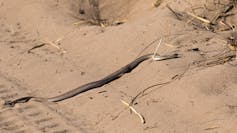A global group of scientists has predicted that climate change may cause dramatic movements in venomous snake populations across many countries in Africa. The scientists took into account climate change predictions about changes to the current habitats of 209 venomous snakes, and mapped where those environments were found elsewhere. Based on this, they predict that snakes were likely to migrate to those African countries whose environments remained suitable for snakes after 2070. This could modify the dynamics of snakebites across Africa.
Macroecology professor Pablo Ariel Martinez, one of the authors of the study, says the international community must take steps now to prevent this from happening.
Which snakes did you study?
Of the 209 venomous snakes we mapped, 43 species were from the African continent. The World Health Organisation classifies venomous snake species into type I (high risk and likely to cause disability or death) and type II (low risk) according to their public health risk.
In our study, 30 of the African snakes were type I – extremely venomous – and 13 were type II.
Join our WhatsApp Channel for more news
Some of the type I snakes whose distribution patterns we predict will change include the carpet viper, black mamba, spitting cobra, and Gaboon viper (one of the largest viper species globally, known for emitting a lethal dose of venom when it bites).
How did you conduct your research?
This was an interdisciplinary study involving researchers associated with public health and ecologists from Brazil, Costa Rica, Spain and Germany. Much of the team consisted of a group of young researchers who are currently pursuing their master’s degrees in the Graduate Program in Ecology and Conservation at the Federal University of Sergipe in Brazil.
We used mathematical models (predictive modelling) to predict where optimal climatic conditions might exist for different snake species to inhabit by 2070.

By knowing the places that snakes could potentially inhabit in the future, we were able to calculate which snakes would start spreading out across a bigger area than their current habitat. This allowed us to assess which species would have the chance to cross geographical borders and inhabit countries where they did not previously exist.
Most snake species – especially those associated with tropical forests – will decrease in number as the climate becomes unfavourable for them. A few species, however, will expand the area in which they live because a favourable climate will exist in other locations, and they will find it.
Why is it a problem if snakes move across borders?
Climate change is affecting the distribution of all species on the planet. Some are decreasing to the point of extinction, while others may shift or even expand their distribution areas. The loss of snakes in one country has negative consequences for people. For example, snakes play a crucial role in controlling other organisms, such as rodents, which can cause various diseases. If snakes die out or if their population reduces, there could be disease outbreaks.
Snake venom is economically valuable too. The venom of snakes is used in making many medications for cancer, neurological diseases, treating high blood pressure, and heart problems. So the loss of snakes would mean the loss of products with high pharmacological value for countries.
The expansion of distribution areas for some venomous snake species can lead to public health problems, though. Often, the only cure for a snakebite is specific antivenom for that species. As a consequence of climate change, some species may cross political barriers, leading to snakebite incidents in countries they did not previously inhabit and where specific antivenom is not readily available.
What did you discover will happen after 2070?
It is estimated that annually between 81,000 and 138,000 people die and around 400,000 are left with permanent disabilities as a result of snakebites. This occurs mainly in east Asia, sub-Saharan Africa, and the neotropical region.
If greenhouse gas emissions continue to increase over time, it is expected that the global average temperature will rise by an average of 5ºC, leading to changes in the distributions of some species. It is anticipated that countries like Uganda, Cameroon, Guinea, Sierra Leone, Nigeria and Somalia will have extensive rural areas dedicated to agriculture and livestock farming by 2070. This is based on information about the future of large of rural or agricultural areas sourced from a global land use database. These same countries will present the right climate conditions to harbour a large number of snake species in the future.
This situation is concerning because snakebites predominantly affect farmers and young rural workers in low-income countries. Bites by venomous snakes kill significant numbers of the livestock owned by smallholder farmers too. Snakebite therefore has economic consequences and can worsen food crises for families and communities in the poorest rural areas.
We also identified some African countries, such as Niger and Namibia, that are likely to receive four to five new snake species from neighbouring countries because of the predicted migration. Their public healthcare systems will need to cope with new types of snakebite poisoning cases.
What can we do to prevent this scenario?
Climate change is mainly driven by human activities. Pollution by high-income countries in the northern hemisphere has been the main contributor to climate change. But its impacts are felt globally, especially in regions of high biodiversity like Africa.
Many high-income countries also benefit from Africa’s vast biodiversity, using its natural resources for medicine, food, scientific research and tourism. Therefore, global measures to strengthen science, research and conservation policies are needed.
Investment in infrastructure in Africa to foster scientific research and effectively address the challenges of climate change is needed.
The research team was made up of Irene Barbosa da Fonseca Teixeira, Tuany Siqueira-Silva, Franciely Fernanda Barbosa da Silva, Luiz Antônio Gonzaga Lima, Jonatas Chaves-Silveira, Miguel Ángel Olalla-Tárraga, José MarÍa Gutiérrez, and Talita Ferreira Amado.
This article is republished from The Conversation under a Creative Commons license. Read the original article.
